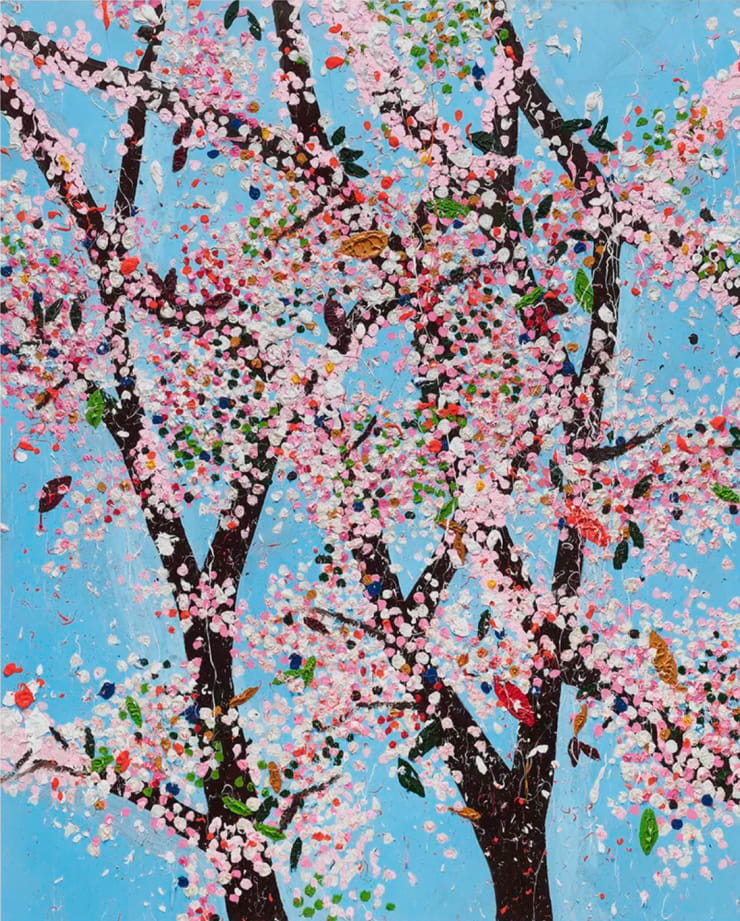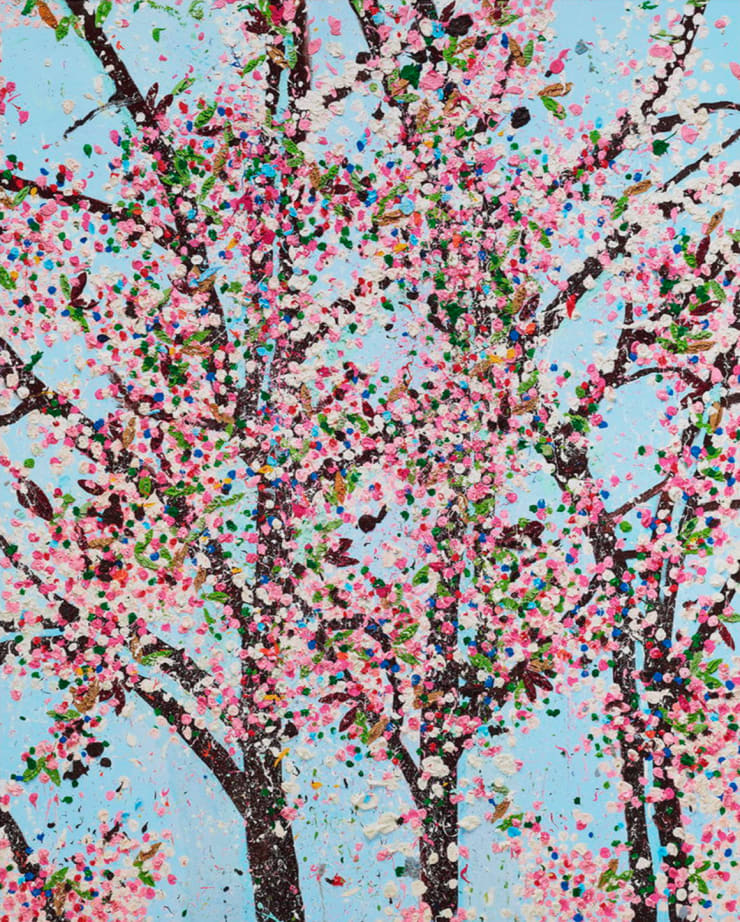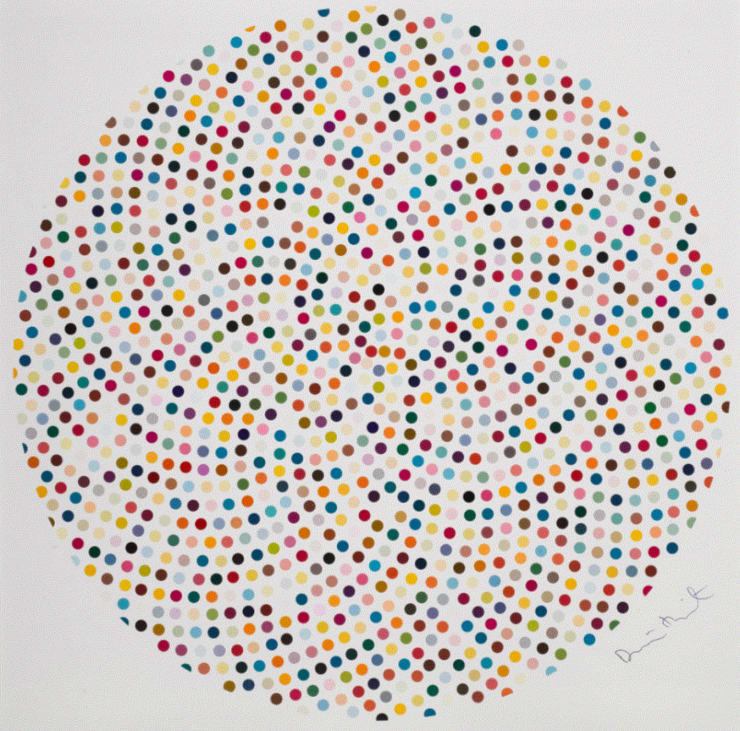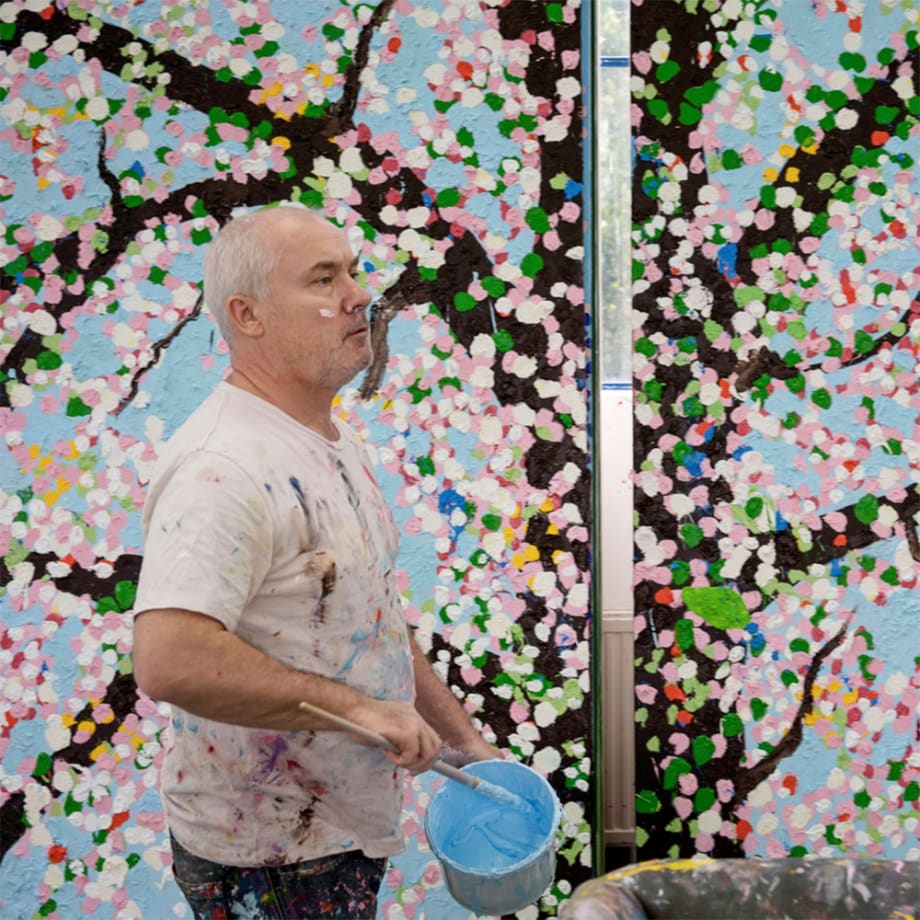Damien Hirst 1965-UK
“I just wanted to find out where the boundaries were. So far I've found there aren’t any. I just wanted to be stopped, and no one will stop me.” - Damien Hirst
Damien Hirst is a British artist who rose to prominence in the 1990s as a leading figure in the Young British Artists (YBA) movement. Known for his provocative and often controversial approach, Hirst challenged conventional art forms through striking installations, sculptures, and paintings. Early works such as The Physical Impossibility of Death in the Mind of Someone Living—a preserved shark in formaldehyde—captured public attention and established his reputation as a bold, concept-driven artist. He has since become one of the most commercially successful and widely debated artists of his generation.
Beyond his early conceptual works, Hirst has explored a wide visual language across media. His Spot Paintings series, featuring meticulously arranged coloured dots, reflects his interest in systems, order, and pharmaceutical aesthetics. In contrast, his more recent Cherry Blossoms paintings (2018–2020) embrace expressive brushwork and vivid colour, offering a more painterly and emotional side of his practice. Whether through sleek minimalism or richly textured canvases, Hirst’s work continues to engage with themes of beauty, mortality, value, and the role of art in contemporary culture.
-
 Damien HirstH9-5 Honesty, 2021Laminated Giclée print on aluminium composite panel47 1/4 x 37 3/4 in
Damien HirstH9-5 Honesty, 2021Laminated Giclée print on aluminium composite panel47 1/4 x 37 3/4 in
120 x 96 cmEdition of 728View More Details -
 Damien HirstH9-6 Honour, 2021Laminated Giclée print on aluminium composite panel47 1/4 x 37 3/4 in
Damien HirstH9-6 Honour, 2021Laminated Giclée print on aluminium composite panel47 1/4 x 37 3/4 in
120 x 96 cmEdition of 693View More Details -
 Damien HirstH9-7 Loyalty, 2021Laminated Giclée print on aluminium composite panel47 1/4 x 37 3/4 in
Damien HirstH9-7 Loyalty, 2021Laminated Giclée print on aluminium composite panel47 1/4 x 37 3/4 in
120 x 96 cmEdition of 1067View More Details -
 Damien HirstH9-8 Control, 2021Laminated Giclée print on aluminium composite panel47 1/4 x 37 3/4 in
Damien HirstH9-8 Control, 2021Laminated Giclée print on aluminium composite panel47 1/4 x 37 3/4 in
120 x 96 cmEdition of 862View More Details -
 Damien HirstAll You Need is Love, 2010Screenprint in colors with diamond dust on wove paper60 x 60 in
Damien HirstAll You Need is Love, 2010Screenprint in colors with diamond dust on wove paper60 x 60 in
152.4 x 152.4 cmSeries: Edition of 50View More Details -
 Damien HirstI Love You (red/gold/pink), 2015Silkscreen, foil block and glaze39 3/8 x 27 1/2 in
Damien HirstI Love You (red/gold/pink), 2015Silkscreen, foil block and glaze39 3/8 x 27 1/2 in
100 x 70 cmEdition of 14View More Details -
 Damien HirstI Love You (red/gold/red), 2015Silkscreen, foil block and glaze39 3/8 x 27 1/2 in
Damien HirstI Love You (red/gold/red), 2015Silkscreen, foil block and glaze39 3/8 x 27 1/2 in
100 x 70 cmEdition of 14Series: 25000View More Details -
 Damien HirstMethylamine-13c, 2014Screenprint in colours with diamond dust on Somerset wove paper33 1/8 x 27 1/8 in
Damien HirstMethylamine-13c, 2014Screenprint in colours with diamond dust on Somerset wove paper33 1/8 x 27 1/8 in
84 x 69 cmEdition of 100View More Details -
 Damien HirstEthidium Bromide Aqueous Solution, 2005Aquatint46 5/8 x 39 1/8 in
Damien HirstEthidium Bromide Aqueous Solution, 2005Aquatint46 5/8 x 39 1/8 in
118.4 x 99.4 cmEdition of 65View More Details -
 Damien HirstLysergic Acid Diethylamide (LSD), 2000Lambda C type print50 x 41 in
Damien HirstLysergic Acid Diethylamide (LSD), 2000Lambda C type print50 x 41 in
127 x 104.1 cmEdition of 300View More Details -
 Damien HirstMethamphetamine, 2004Etching in colors on Hahnemühle paper80 x 43 in
Damien HirstMethamphetamine, 2004Etching in colors on Hahnemühle paper80 x 43 in
203.2 x 109.2 cmEdition of 115View More Details -
 Damien HirstTetrahydrocannabinol, 2004Etching43 3/4 x 79 in
Damien HirstTetrahydrocannabinol, 2004Etching43 3/4 x 79 in
111.2 x 200.6 cmEdition of 115View More Details -
 Damien HirstValium, 2000Lambda C type printheight 49 3/8 in
Damien HirstValium, 2000Lambda C type printheight 49 3/8 in
height 125.5 cmEdition of 500View More Details -
 Damien HirstOpium, 2000Lambda C type print18 7/8 x 16 7/8 in
Damien HirstOpium, 2000Lambda C type print18 7/8 x 16 7/8 in
48 x 43 cmEdition of 500View More Details -
 Damien HirstMickey Glitter, 2016Screenprint with diamond dust34 1/4 x 27 1/2 in
Damien HirstMickey Glitter, 2016Screenprint with diamond dust34 1/4 x 27 1/2 in
87 x 70 cmEdition of 150View More Details -
 Damien HirstMinnie Glitter, 2016Screenprint with diamond dust34 1/4 x 27 1/2 in
Damien HirstMinnie Glitter, 2016Screenprint with diamond dust34 1/4 x 27 1/2 in
87 x 70 cmEdition of 150View More Details
Emerging in the late 1980s as a leading member of the Young British Artists (YBA) movement, Hirst quickly became known for his bold, confrontational works that challenged traditional ideas about art, value, and spectacle. Alongside artists such as Tracey Emin, Jenny Saville, and Angus Fairhurst, he helped to reshape the British art scene in the 1990s with work that was both conceptually ambitious and visually striking.
Hirst’s art spans a wide range of media, including painting, sculpture, and large-scale installation. A consistent hallmark of his work is a fascination with systems, repetition, and the aesthetics of science and medicine. His Spot Paintings series—begun in the late 1980s and now numbering in the hundreds—features grids of colored circles, meticulously spaced and painted in precise, uniform style. The works evoke both pharmaceutical design and minimalist abstraction, combining clinical detachment with unexpected visual rhythm.
His interest in visual systems and mass production is echoed in many other projects, from his vitrines to his more recent explorations of painting. In 1992, Hirst created Pharmacy, an immersive installation that mimics the interior of a chemist’s shop, complete with medicine cabinets and clinical lighting. Rather than simply recreating a familiar space, the work plays with ideas of order, trust in science, and the fine line between artifice and reality.
While Hirst is well known for controversial pieces like The Physical Impossibility of Death in the Mind of Someone Living—a preserved tiger shark suspended in formaldehyde—his practice has also expanded into more traditional and expressive territory. His Cherry Blossoms series (2018–2020) marks a significant stylistic shift: large-scale, heavily impastoed paintings of flowering trees rendered in vibrant, explosive colour. These works celebrate gesture, texture, and surface, drawing on art historical references from Impressionism to Abstract Expressionism while showcasing a more emotional, painterly side of Hirst’s practice.
From diamond-encrusted sculptures to hand-painted canvases, Damien Hirst’s work continually pushes boundaries and provokes conversation. Beyond his reputation for controversy, he remains a prolific and versatile artist whose wide-ranging practice has left a lasting mark on the contemporary art world.

















